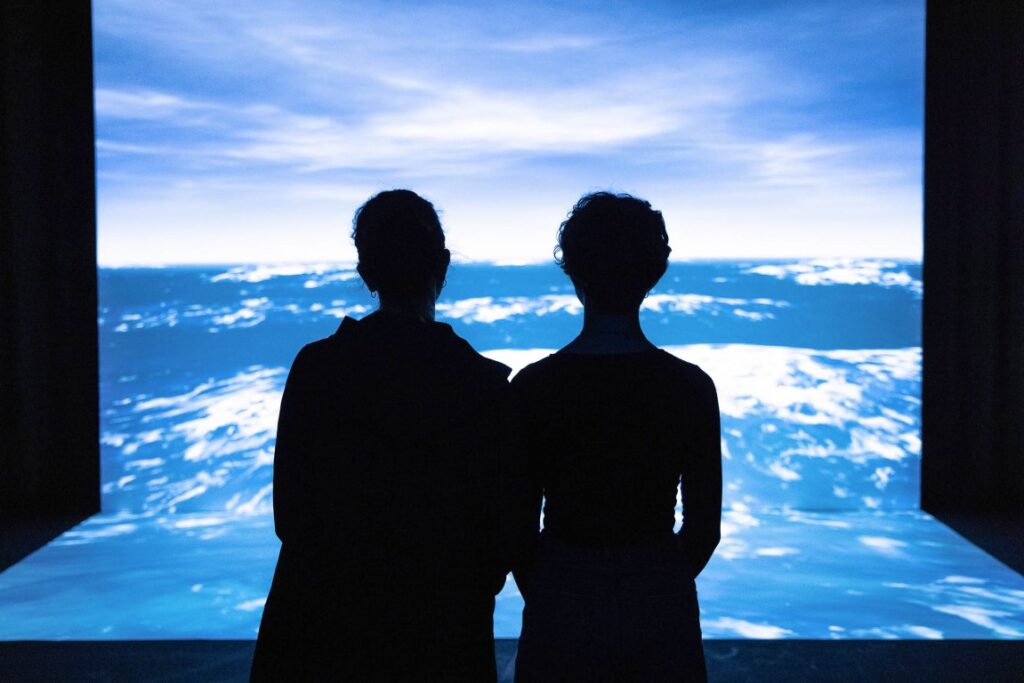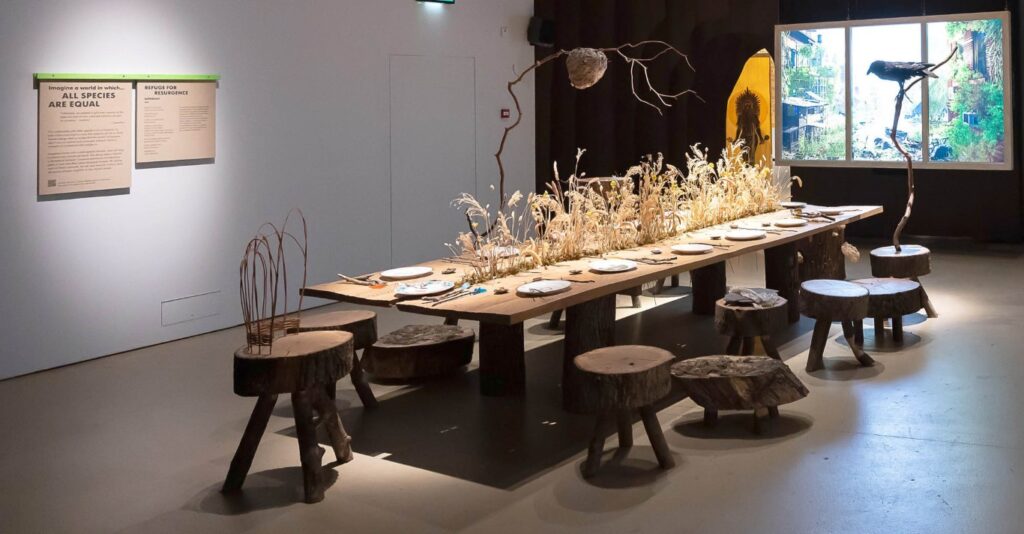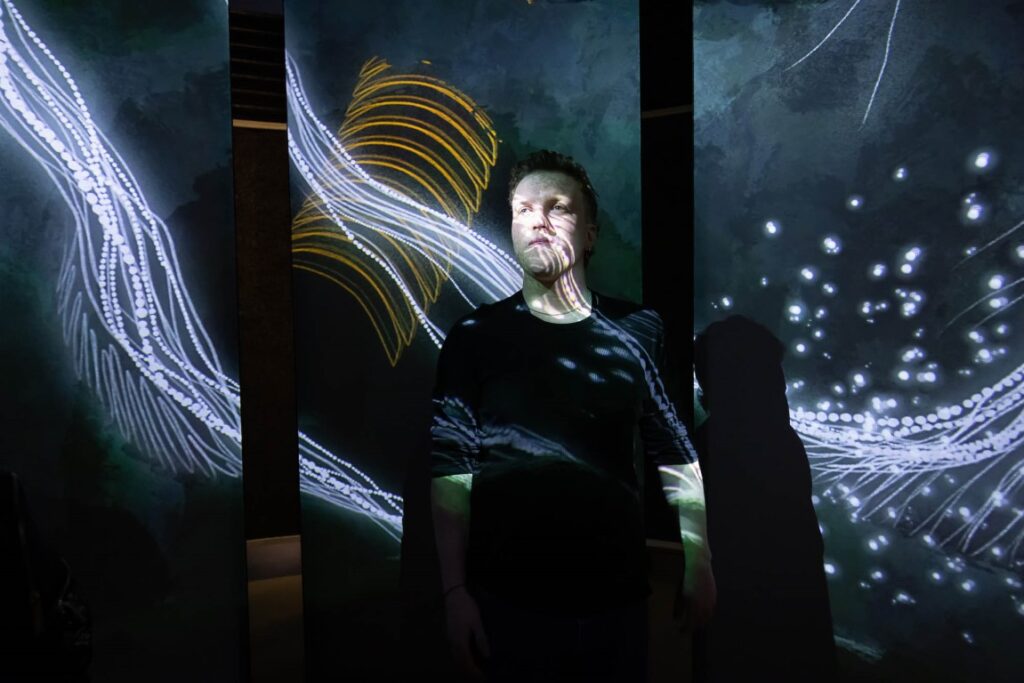What does it mean to live in the world, coexisting with other living things great and small? What does it mean to be both stewards and residents of our shared planet? And how can we reimagine a future where everyone and everything can thrive in harmony?
Those are some of the big ideas of “Our Time on Earth,” an ambitious, imaginative, and inspiring exhibition on view at the Peabody Essex Museum through June 9 that uses art and science to explore themes of conservation, cross-species existence, climate change, biodiversity, indigenous knowledge, and more.
“The environment is a huge subject within the art world, but often the people that know the deep stories are the scientists,” says Trevor Smith, PEM’s curator of the Present Tense Initiative and associate director of multisensory experience.
“Our Time on Earth” understands that and embraces it for the benefit of viewers.

Barbican Centre. © Tim P. Whitby/Getty Images
“It’s a major exhibition of about 18 different multisensory and participatory installations that have been created, by and large, by cross-disciplinary teams,” Smith says. “Artists and designers are being paired with climatologists and scientists of various stripes.”
Originally organized by the Barbican Centre in London, “Our Time on Earth” includes installations created by teams of artists, designers, scientists, technologists, and other visionaries from 12 countries. Its PEM appearance marks the exhibition’s United States debut.
Rather than simply presenting art on a wall for personal contemplation, “Our Time on Earth” is immersive and engaging, encouraging visitors to experience the art with all of their senses and be active participants in it. That’s important not only because humans learn in a “multisensorial way,” but also because of how closely these issues affect all of us, Smith says.
“In fact, we are talking about issues that surround us,” he says, “that we are already immersed in.”
The exhibits take visitors on a journey through the vastness of life, from a 3D, audiovisual, virtual ocean filled with magnified plankton to an interactive video installation where viewers control the movement of pollen, spores, and mushrooms, and more.
“One of the intents of the show is to have people experience the installation . . . from an embodied place,” says Jane Winchell, the Sarah Fraser Robbins director of PEM’s Dotty Brown Art & Nature Center. “We are feeling in our bodies the climate disruptions that are happening. And so this is a way of tapping into that from a place that is offering ways to feel connected, to feel moved.”

Barbican Centre. © Tim P. Whitby/Getty Images
She points to “Refuge for Resurgence,” a giant, wooden table that’s set with place settings for 14 guests that include not only a man, woman, and child, but also a fox, rat, wasp, pigeon, cow, wild boar, snake, beaver, wolf, raven, and mushroom.
“Each place setting is set with that organism in mind, whether it’s a pest or an organism we have considered to be food itself for humans,” Winchell says. She believe the piece captures the idea that “we are part of something that’s so much bigger than just ourselves. That we are one among millions of species, and living from that perspective is going to be really important because we need a healthy planet if humans are to survive. This piece, for me, really foregrounds that, the idea of really expanding who is welcome and who we appreciate.”
Other standout pieces include “Sonic Waterfall,” a sound and light installation that uses sonic frequencies to create a healing, calming environment that Smith describes as “almost mythic.” There’s also “Sanctuary of the Unseen Forest,” an awe-inspiring, multisensory vision of a giant, Amazonian Ceiba pentandra tree “as a living being and a dynamic entity,” Winchell says.

Installation view of the Our Time on Earth exhibition at the Barbican Centre, 2022.
The exhibition is presented as part of PEM’s Climate + Environment initiative, through which the museum aims to mitigate its own environmental impacts. With that in mind, Our Time on Earth also includes a section called “Be the Change,” which encourages visitors to share their own ideas and thoughts about the climate and environment, as well as choose a way to take personal action in the “Count Us In” station.
“We’re constantly having to take off the accumulation of messages from people because there’s been so much response and really thoughtful reactions and artwork,” Winchell says.
PEM is walking the sustainability walk with the exhibition itself, too, by reusing many of the original, sustainably sourced exhibition elements, graphics, and signage from the Barbican’s presentation in London.
“Rather than generating a whole new set of things here, we’ve been able to reuse those materials, which never happens in museums,” Smith says. “But we felt it was really important with this exhibition to try to do that.”
It’s all part of how Our Time on Earth—and PEM itself—uses art to help people feel more connected to themselves, the planet, and each other, and in doing so, encourages them to be part of changing the world for a better, more sustainable future.
“The art is really helping to contextualize what is happening,” Winchell says. “To be sparking conversation and motivating action and inspiring creative solutions to the planetary crisis.”

